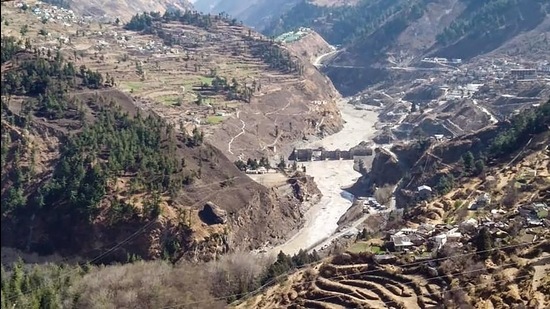Stability of rocks, river flow in Rishi Ganga needs careful monitoring: Analysis
The analysis by GAPHAZ underlined that large volumes of debris have been eroded and deposited along the river channel after the breach
An analysis of the February 7 Uttarakhand glacier breach has cautioned that the stability of remaining rocks or ice masses and slopes around the rock that detached needs to be monitored carefully to prevent more disasters. The ice and rock mass detached at an elevation of 5,600 m from a north-facing slope northeast of Trisul peak in Nanda Devi mountain.

The analysis by Glacier and Permafrost Hazards in Mountains (GAPHAZ), a scientific standing group of the International Association of Cryospheric Sciences and the International Permafrost Association, underlined large volumes of debris have been eroded and deposited along the river channel after the breach. In combination with water from rivers, snowmelt, heavy monsoon rain, or overflow of temporary lakes, debris flows can be triggered from these depositions and pose danger downstream.
Also Read | Scientists warn of rebound after record 7% fall in global emissions
The analysis said it is difficult to assess the state of the temporary lake at the confluence above Raini village from remote sensing data alone. Dam conditions need to be critically analysed and erosion by the flood has probably undercut some slopes. “Some high-resolution satellite images indicate tension cracks on and above slopes with signs for movements, but it is difficult to evaluate the evolution of these cracks and attribute them to the February 7 avalanche. Detailed evaluation and monitoring of the slopes along the entire stretch of the river are recommended. Such slope instabilities could affect roads, villages, and other infrastructure located far above the riverbed,” the analysis said.
GAPHAZ cited early findings by geologists that a major rock/ice avalanche caused the massive floods in the Rishiganga river and left scores dead and missing.
Analysis of satellite imagery from the area shows that the event occurred due to failure deep within the bedrock of the mountain, and the glacier ice was most probably entrained with the collapsing block of bedrock.
The depth of the failure plane is more than 100 m below the surface, where no seasonal temperature variations are expected. The zone is in permafrost conditions where ground temperatures are below zero. Some have speculated that heat fluxes from the warmer south face of the mountain to the colder north face, where the avalanche detached, could have warmed the frozen bedrock, leading to the avalanche.
According to estimates by GAPHAZ, the avalanche volume was 20 million m3 of rock (83%) and calcium; 4 million m3 of ice (17%). This puts the event into a category of the largest contemporary mass movements in mountains on a global scale, says the analysis.
The very steep avalanche trajectory, dropping around 2000 m in elevation over a distance of about 3.3 km, indicates the release of high impact energy. Along with the entrainment, most of the ice of the avalanche may have melted. In addition, the area under snow may have also melted due to the frictional energy of the avalanche leading to run-off.
Liquid water from snow and ice melting could have infiltrated the bedrock in cleft systems and destabilised the rock through freeze-thaw processes, the analysis has suggested.
Satellite imagery also indicates that a similar event occurred in the neighbouring glacier in September 2016.
Anil Kulkarni, distinguished scientist, Divecha Center for Climate Change at Indian Institute of Science, said it is true that there was a major ice or rock avalanche, and part of a hanging glacier came down with it. “We have calculated the ice volumes which is in millions of cubic metres. The slope was around 30 degrees. But what is not known is what triggered the melting of this ice. There is some speculation that it was in a soft, deglaciated valley which led to melting but that is crucial information which is still missing.”
Carolina Adler, executive director, Mountain Research Institute, University of Bern, said in the longer term, it is inevitable that in such high, remote, steep, sensitive, rapidly warming, and deglaciating environments, large infrastructure projects can be exposed to considerable natural risks. “However, a paucity of long-term, informative data, the likelihood of climate change-induced non-stationarity, and the complex, cascading nature of such events make these risks extremely challenging to quantify reliably,” Adler said in a statement. “It may therefore be appropriate for the viability of such infrastructure projects to be reappraised. At the very least, in order to protect people and infrastructure who are inherently in harm’s way (e.g. hydro-electric power stations), ongoing multi-variate monitoring of upstream environments, coupled with early warning systems that exploit modern technology and associated mandatory drills, would seem imperative.”
Get Current Updates on India News, Lok Sabha election 2024 live, Election 2024 along with Latest News and Top Headlines from India and around the world.



